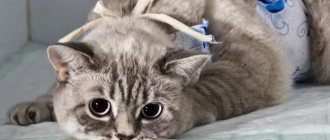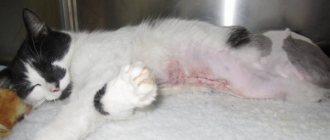- July 11, 2019
- Cats
- Irina Tsirikhova
“We are responsible for those we have tamed” - these words of A. Exupery should be remembered by those who are planning to get a cat or other living creature. Our little brothers have many needs, and you should be aware of this, since the owners will have to bear responsibility for the consequences. For example, the appearance of offspring is a big problem. The solution may be sterilization. How long does it take for cats to recover from anesthesia after it and how does this happen? This process is not easy and requires preparation.
Animal needs
Why do people even get cats? We are talking specifically about “girls”, since their appearance in the house means that soon, at least in a year, “happiness” awaits you in the form of additional meowing from several more living creatures. In addition, before this you will be faced with the needs of your pet, which she will loudly declare. That's right - she's in heat and she needs a cat.
If you have a purebred aristocrat, then the problem of a partner for her becomes even more complicated - not every cat is suitable. As they say, purity of blood comes first. If you have an ordinary cat, then the cat issue still requires a solution, but it may happen that the cat herself will show enterprise, and you will learn about her choice when she lambs.
By the way, she can repeat this about 4 times a year.
Did you know about this? It is possible that such a prospect has not occurred to you, but these are the realities. And so, after sound reflection (and it’s good if they visit you before the offspring appears), you began to think about sterilization. How cats move away after it and what consequences this process is associated with - this is what we will discuss.
General information
As you know, castration in most cases refers to an operation to remove the testes of a cat. Of course, there are less traumatic options when the testicles are preserved, but still in 90% of cases they are cut out. The operation itself is extremely simple and rarely requires full anesthesia. But in recent years (mainly for humanitarian reasons), even in this case, general anesthesia is increasingly used. It is not surprising that after recovering from anesthesia, a cat may vomit. This phenomenon is not absolutely normal, but it also does not pose any particular danger.
Very often, vomiting in a cat after castration is a consequence of gross non-compliance with the basic rules of preparation for surgery:
- The animal must not be fed at least 12 hours before the procedure. Ideally, this period is immediately increased to 16 hours.
- Two to three hours before surgery, the cat must not be given water.
- It is strictly forbidden to perform castration in cases where the pet is sick with something (this also includes severe cases of helminthic infestations).
In addition, immediately after recovery from anesthesia, your pet should not be given water (at least three hours later), and there is no talk of food at all!
You should wait about 12 hours, and only then start feeding the hungry cat. And this must be done using liquid broths. It is believed that a pet can be returned to its normal diet only after a few days. This way, his body is guaranteed to recover from the effects of anesthesia.
If you immediately give meat in pieces on the 2-3rd day, you shouldn’t expect anything good. The animal’s digestive system is still “inhibited” at this time, and therefore not only vomiting, but also diarrhea may develop. And all because the food will be poorly digested and will begin to rot, resulting in intoxication.
Remember, at least on the first day you should not give your cat anything “heavy”! If you want to pamper your pet, give him some commercial food specially designed for feeding sick and weakened animals.
It should be taken into account that tracheal intubation is often required during anesthesia. If this operation was not performed carefully enough, the walls of the organ are injured. The cat develops a feeling of intense tickling and develops a “metallic”, “barking” cough, which causes the animal to vomit. What other reasons contribute to vomiting?
Other predisposing factors
It happens that some cats come to their senses surprisingly quickly after anesthesia and feel good about it.
This, of course, is wonderful, but only in such cases the pet can begin to lick itself, and it will pay special attention to the “gutted” scrotum. And in her cavity after the operation there will be powder or something similar
It often happens that a cat vomits violently precisely because he has drunk too much levomikol or something similar. And vomiting in this case is the least of all problems. If a pet begins to lick a post-operative wound, suppuration will almost certainly develop, and the animal may die from sepsis and other dangerous phenomena.
It is also possible that your cat was suffering from a severe helminthic infestation at the time of castration. Toxins released by parasites can enter into a “symbiosis” with drugs administered during anesthesia. But there are also more dangerous factors. So, vomiting may indicate intestinal volvulus. Again, this often happens in cases where “compassionate” owners fed the operated pet heavily before surgery or immediately after recovery from anesthesia.
Real life
The lifespan of a pet depends on many factors - living conditions, feeding, breed and frequency of reproduction of offspring (if it is a female). Too often repeating the process of childbearing shortens a cat's lifespan. In addition, several times a year owners have to solve the problem of arranging newborn babies, and there can be from 2 to 6 of them. You can, of course, approach the issue radically, but few people today would raise their hand to drown the kittens.
On average, cats live from 5 (street) to 15 (indoor) years. The courtyards walk on their own and breed as they please. The offspring grow up and join the ranks of “street children”, which is associated with diseases (including sexually transmitted diseases), death from natural causes or at the hands of child predators (which is often the case lately).
Volunteers are trying to solve the problem of uncontrolled reproduction of stray animals through sterilization. But this is a drop in the bucket...
Literature:
- Causes and consequences of bad habits: textbook / L. G. Ovcharova, L. S. Khoroshilova, Z. A. Kurbatova; Ministry of Education and Science of the Russian Federation, State. higher educational institution prof. education "Kemerovo State. univ." - Kemerovo: Kuzbassvuzizdat, 2006. - 115 p.
- Drug addiction (nature and overcoming): textbook / S. K. Bondyreva, D. V. Kolesov; Russian academician Education, Moscow Psychological and Social Institute. - Moscow ; Voronezh: Moscow Psychological and Social Institute, 2006. - 430 p.
- Cocaine, pervitin and other psychostimulants: Advice from doctors for teenagers and their parents / A. Danilin. - M.: Tsentrpoligraf, 2000. - 281 p.
Need some advice?
OR CALL A DOCTOR
CALL!
+7
Two ways to solve the problem
The solution to the problem for pets may be either taking pills that eliminate the appearance of sexual desire, or sterilization. How long cats go away after it depends on their state of health. However, it is possible to assume a general algorithm for the rehabilitation process.
But before you think about how long a cat will live after a sterilization operation, you need to decide on the possibility of this option.
It is no secret that there are plenty of prejudices against this procedure, and there is also a moral aspect - after all, you are depriving your pet of the joys of love... Here everyone decides for himself, if you are afraid, then it is better to choose another option.
In this case, you will consciously meet each new generation of your pet, and your responsibilities will also include casting the prospective partners of your cat. This is necessary, because otherwise she will face hormonal imbalance and health problems, not to mention a change in mood during the period of estrus.
The choice is made
This part of the article is intended for those who have made their choice and now want to know how long a cat will live after sterilization and how to care for it after surgery.
Before moving on to the details, I would like to reassure the owners about the pet’s quality of life. Thanks to the stabilization of hormonal levels, she will become calmer and more affectionate, show more intelligence, and her life years will increase by 5 or 10 years, and she will be able to celebrate 20 or more birthdays. This is due to the fact that cats spend a lot of physical effort on bearing and raising offspring. And if you consider how many times during their lives they do this, it is not surprising that the payment for this is measured in years.
Well, to the question of how long it takes for cats to recover from anesthesia after sterilization, we answer: from 2 to 3 days.
Important Takeaways
Some operations are performed only once in a lifetime (sterilization of a dog, sterilization of a cat, castration of a male or female cat), so let this surgical intervention be carried out in excellent conditions and with fully controlled anesthesia.
Take the time to find a veterinary clinic that offers gas anesthesia, and don’t skimp on traveling if the chosen facility is far from you. It's worth it!
Easy awakening after inhalation anesthesia
And if any procedure (for example, brushing teeth) or surgery (for injuries and other pathologies) must be performed more than once for forced reasons, then choosing inhalation anesthesia at some point may simply save the life of your cat or dog.
Details about sterilization
Of course, you should know that the sterilization operation can be of three types:
- The first option is a partial abdominal surgery, during which either the ovaries or the uterus are removed from the animal.
- The second option is also partial - the cat can simply ligate the fallopian tubes.
- The third option is complete sterilization, in which the uterus is removed along with the ovaries.
Your veterinarian can tell you about the details and consequences of each operation. He will confirm to you that it is better to sterilize a cat before her first heat. The optimal age is from 8 months to one and a half years. This way you will protect your pet from complications after sterilization. How long it takes for a cat to recover from surgery depends on the quality of your care. By the way, it is necessary to constantly monitor the animal in the first days, and therefore it would be useful to take a vacation.
How cats recover from anesthesia after castration - features of the condition
The process of recovery from anesthesia is individual. Some pets behave aggressively, others wake up slowly and remain lethargic for a long time. An inexperienced pet owner runs the risk of being bitten or scratched.
The side effect of drugs is prolonged disorientation in space and impaired coordination of movements. To prevent the consequences of physical activity, the cat is placed in a place from which it cannot fall. The best option is to leave it in a carrier for a while, in a warm, dry place without drafts and away from heating radiators.
Be sure to read: Complications after castration of a cat: causes, types, symptoms and treatment, when you need to see a doctor
First 6 hours after surgery
So, you have chosen the most suitable option for surgical intervention and carried it out in the clinic. The procedure is completed, and your further actions for several hours will be to wait.
As a rule, after surgery, the animal’s condition should be monitored by a doctor. Therefore, the cat will sleep soundly during the first hours in the clinic. If her temperature is normal, then the patient can go home, where you will care for her as long as the cat recovers from anesthesia after sterilization. Further in stages:
- When your cat wakes up, you may be slightly frightened by her appearance: the expression in her eyes will be blank, the iris itself will be covered by the pupil. In addition, there will be no reaction to light. To restore the eyes, you should use “Artificial tear” drops, which moisturize the mucous membrane. The cat will not be able to blink on its own, and this is necessary, so the owner will have to help the pet by closing and opening her eyelids with his fingers. Next, you should continue to use the drops regularly to avoid conjunctivitis.
- In the first hours (from 2 to 5) after surgery, the cat may be subject to involuntary contraction of certain muscle groups. Don't be alarmed.
- The animal is very weakened, and therefore will have difficulty getting up on its legs. It is likely that the cat will not be able to do this in the first 5 hours. However, if after the 6th hour this has not happened (at least for 1 second), then you should return to the clinic for examination.
- The animal may meow and even simply scream after waking up. This is how cats recover from anesthesia. How long will this last? Normally it takes about 5 hours, but if it lasts longer, then something is wrong with her and she needs to worry about the doctor again. In principle, such an arousal reaction is quite predictable and similar to the human one.
Effect of cocaine
Cocaine is an alkaloid with a strong stimulant effect, found in coca bushes. It has been used for more than 5000 years. The most common method of administration is intranasal (through the nose). There is also a type of cocaine for smoking - crack, and injection solutions.
Intoxication begins 5–10 minutes after taking the drug. It is characterized by:
- lifting the mood;
- feeling of a surge of energy and vigor;
- increased motor activity, a person begins to talk and move a lot;
- there is a tendency to overestimate one's own capabilities.
The peak occurs within 15–20 minutes, and after 30 minutes the effect wears off. After euphoria, apathy, lethargy, and drowsiness develop.
The withdrawal state is very difficult to tolerate, patients experience:
- severe headaches;
- depression;
- various vegetative disorders;
- suicidal thoughts and delusions appear.
When taking large doses of cocaine, fainting may occur due to constriction of blood vessels in the brain. This appears:
- severe weakness;
- pale face;
- dilated pupils;
- dyspnea;
- convulsions;
- tachycardia;
- psychomotor agitation with impaired consciousness.
The person experiences anxiety and fear, visual, tactile and auditory hallucinations.
During this period, it is important to have specialists nearby who know how to remove cocaine from the body and alleviate the patient’s difficult situation.
Long-term use of cocaine causes:
- sharp asthenia;
- general weakness and lethargy;
- problems with appetite (it is either increased or completely absent);
- perforation of the nasal septum, due to impaired trophism and constant vasospasm when inhaling powder through the nose;
- mental disorders;
- moral degradation.
Long-term consequences and care
If the first 6 hours went normally, then this is not a reason to relax: how long cats recover from anesthesia after sterilization is a matter of the individual characteristics of the animal’s body. Let's follow the process further:
- After 6 (at best 5) hours, your pet will make weak attempts to walk. The sight is sad - she will even trip over a matchbox, not to mention collisions with furniture. The cat's gait will resemble Brownian motion - chaos and uncertainty. At this time, you are not just observing, but facilitating its safe movement across the territory. She can't jump (the seams will come apart) and your task is to help her climb onto and off her favorite sofa.
- This will continue for about a day, but with each passing hour your cat will become more and more confident in overcoming obstacles. For your peace of mind and its safety, you should not leave your cat for one day or the next.
- It will take about a day before she can start drinking and eating. If you start feeding her earlier, you will get a gag reflex. By this time, the condition of her eyes will be restored (with proper care).
- It should be noted that force-feeding a cat after surgery is completely unnecessary - she herself will feel when she needs to eat. After 48 hours or so, your pet may begin to compensate for the forced period of fasting. And this will be very obvious, since the animal is really hungry. To avoid complications, purchase special food for a sterilized cat.
- Your cat's behavior will be almost completely restored in three days, and possibly earlier.
Precautionary measures
And now, after you have found out how long it takes a cat to leave after sterilization, let’s discuss preliminary precautions. They must be taken into account before surgery and followed after it.
First of all, it is necessary to remember about the postoperative decrease in the animal’s body temperature. This means that you should take care of warm bedding and a blanket to provide a comfort zone for the cat.
After sterilization, your pet will need a blanket that will protect the seams from licking. It should be put on immediately after surgery and removed only to treat the incisions. A collar is needed for the same purpose.
In addition, the cat needs to arrange a rookery on the floor (in no case on an elevated surface), since in the first two days it will have problems with coordination, and it will not have enough strength to jump. In addition, if she falls off the sofa, the seams may come apart. It is better to place the cat on its right side to avoid strain on the heart.
Feeding during rehabilitation
After waking up, 5-6 hours later, the cat can be offered a drink of water, but not food. Since the animal will be weakened, you can give it something to drink using a pipette or syringe without a needle. The pipette can be replaced with a Naphthyzin bottle, which is much more convenient.
The cat should be fed its usual food, but in case of any complications (after consultation with a doctor), you can switch to special postoperative food or boiled chicken meat.
After anesthesia, the animal may experience nausea. Before vomiting, a cat will usually lick itself frequently. The owner should not lose sight of the pet for a long time, as it may choke on vomit.
Temperature control
Temperature control is an important part of postoperative care. This should be done regularly using an electronic thermometer, inserting it into the animal's anus. For such manipulations, you will need an assistant.
If it is not possible to measure the temperature rectally, then use the old-fashioned method - feel the cat’s nose. If it is dry and hot for a long time (about 4 hours), then calling a specialist or transporting the animal to the clinic is highly recommended.
Monitor your pet's condition - the presence of a rapid heartbeat or rapid breathing indicates an inflammatory process in the suture area.
A slight increase in temperature of 0.5-1 degrees is quite understandable. In this case, the cat must be given water every half hour and the dynamics of its condition must be monitored. There should be no drafts in the room where the animal is located and a comfortable temperature should be maintained.
The main goal of all these precautions is to prevent complications in the cat.
Other manifestations
If you decide to undergo sterilization, then the willingness to show patience and care for your pet should be assumed a priori. Because your cat will need affection and understanding more than ever.
You should be prepared for the fact that the animal will experience involuntary drooling in the first hours after surgery. The cat may also try to crawl to a secluded dark place and hide there. Therefore, take into account her need for this when you make her bedding.
In addition, your cat may have involuntary discharge of feces or urine. Naturally, she should not be scolded for this.
And lastly: only after your pet returns to its previous lifestyle, you can leave it unattended for a long time.
Does anesthesia harm a cat's body?
This type of operation is performed under the influence of Propofol.
According to veterinarian E. Kornyushenkov, general anesthesia does not affect the life expectancy of a pet. Before the operation, the cat is examined by a doctor and assesses its health. Since the operation is performed once in a lifetime, the dose of anesthesia does not significantly affect vital organs. The most dangerous drugs are considered to be “Chloroform” and “Ftorotan”, which have a very negative effect on cardiac activity, but they are no longer used in veterinary medicine. To sterilize or groom a cat, Propofol or Vetafol in combination with analgesics is most often prescribed. These are high-quality drugs, but occasionally side effects may occur in the form of a decrease in blood pressure or respiratory arrest. Anesthesia affects the body in this way:
- metabolism slows down;
- temperature decreases;
- breathing becomes rare;
- hypertension or hypotension is observed;
- heart rhythm is disturbed.











